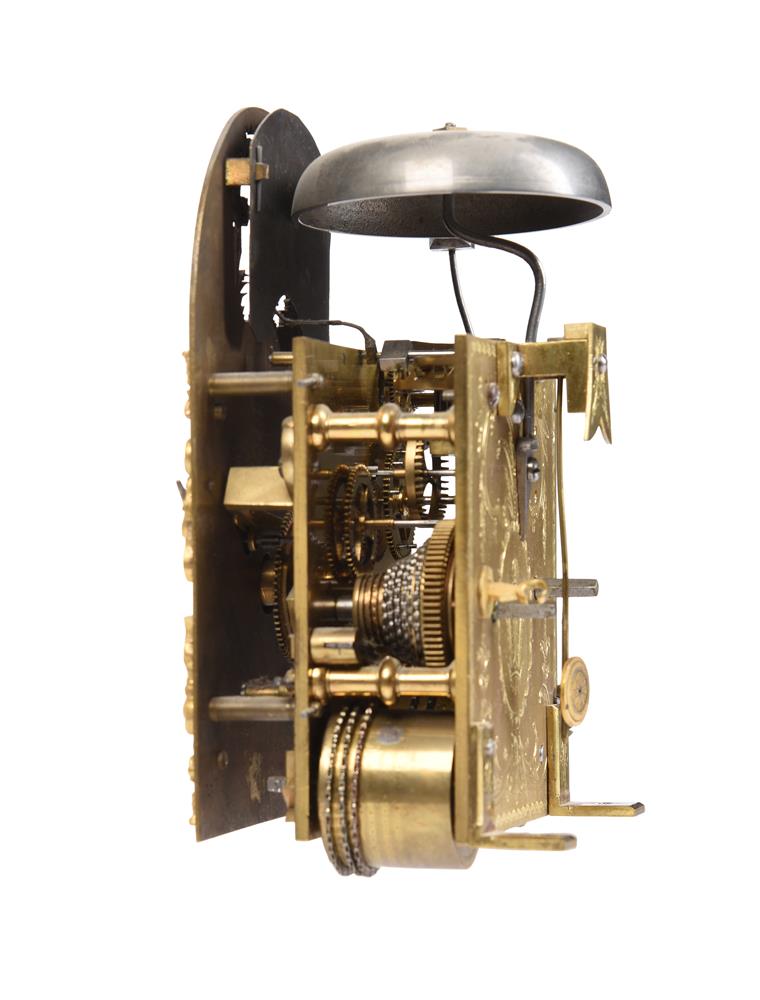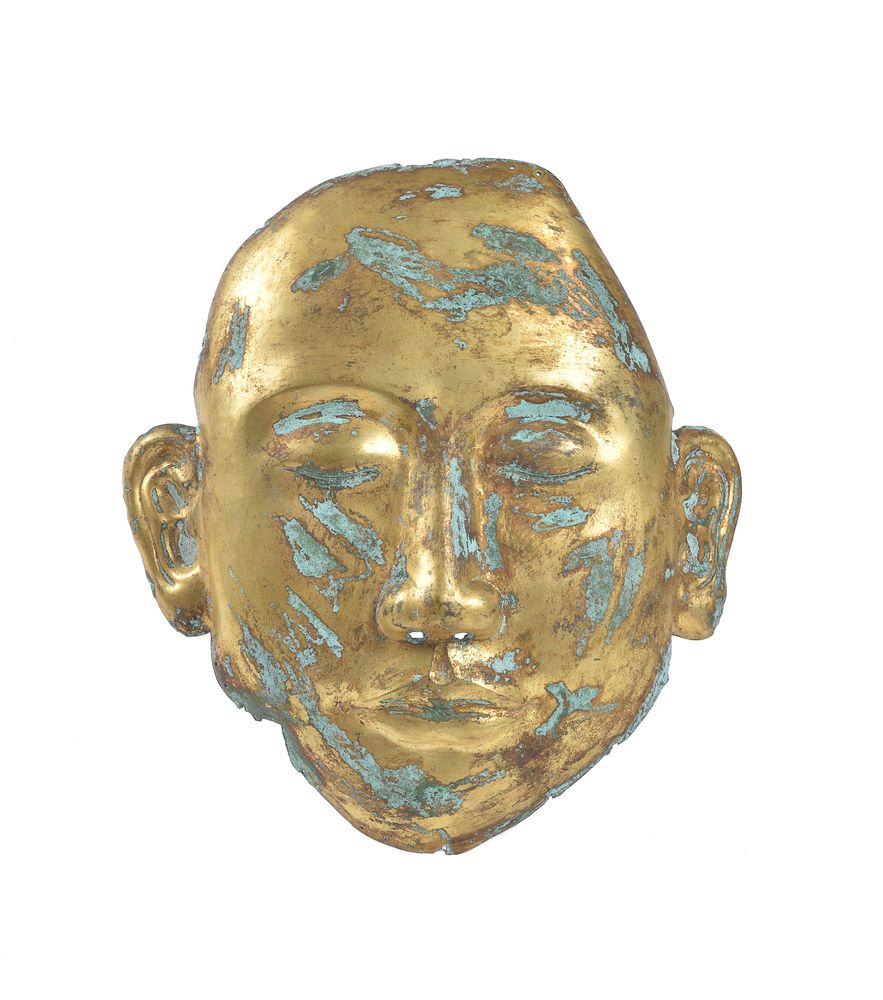A RARE CHINESE GILT BRASS MINIATURE TABLE CLOCK WITH ROCKING FIGURE AUTOMATONUNSIGNED, PROBABLY GUANGZHUO WORKSHOPS, EARLY TO MID 19th CENTURYThe four knopped-pillar twin chain fusee back-winding bell striking movement with plates measuring 4.25 by 3.5 inches, Knife-edge pivoted verge escapement regulated by short disc bob pendulum and fitted with foliate motif engraved backcock apron, the backplate finely engraved with a central oval panel containing Prince-of-Wales feathers issuing from a coronet onto vertically hatched background, within a field of symmetrical Neo-Classical inspired leafy scrollwork bordered a slender wavy band, the 4.25 by 6.25 inch arched gilt brass dial applied with convex fired white enamel hour disc with minute band divided into fifths and Arabic fifteen minutes to outer track, with pierced gilt brass hands and chased gilt rosette-and-scroll pierced spandrels beneath arch painted in tones of red, blue, cream and brown with a figure of Chronos rocking with the motion of the pendulum between two trees within a European inspired lakeland landscape, the arched fire-gilded brass case with lobed orb finial to the ogee-shaped canopy superstructure applied with leafy scroll-chased mounts between beaded borders, the front with bead decorated hinged arched glazed brass door beneath shell-centred crest issuing leafy trails and pendant husks continuing down the front edges to flank the dial aperture, the sides with symmetrical scroll-cast mounts over oval fretwork panels each pierced and chased with blooming foliage within surround of repeating lappet-leaves decorated with further scrolling motifs to upper and lower margins, over swollen base sections applied with delicate pierced and chased fretwork mounts, the rear matching the front and raised on four leaf cast and chased scroll feet onto a fixed brass-topped hardwood plinth base applied with acanthus cast ogee moulding and with squat bracket feet.39cm (15.5ins) high, 22cm (8.625ins) wide, 15,5cm (6.125ins) deep. The Chinese pre-occupation with mechanical timepieces can trace its roots back to the Court of the Wanli emperor who received as a gift two timepieces from the Jesuit priest Matteo Ricci in 1601. During the 18th century (from Kangxi reign onwards) exotic musical automaton timepieces became highly desirable and thus a very important commodity with regards to maintaining healthy trade relations between London and the Chinese Court. By the time of the reign of the Qianlong emperor such examples of the clockmaking art had become so fashionable that they were often traded as gifts to eminent officials and wealthy merchants as well as the Court itself.Mechanical clocks also had a symbolic purpose to the emperor signifying the ability to master the time and the calendar. As such they cemented his position as the Son of Heaven of having divine powers and the ability to control the transcendence of time in the Universe. Clocks were also valued for their practical applications and symbolised the smooth running of the emperor's administration through efficient time management. This significance is perfectly illustrated by a poem composed by the Kangxi emperor entitled 'The Chanting of the Chiming Clock' which translates as: Methods originating from the West taught us with a keen heart.Wheels circle on a quarterly basis, hands move according to minutes.Dawn needs not to ne announced, golden clock reports in advanceWork hard on government affairs in the morning, memorials are never completed in a late manner The Qianlong emperor's interest in the clockmaking art led to the expansion of the imperial workshops employing both Chinese and European clockmakers. These skilled artisans were given unrivalled access to the finest raw materials available at the time including gold, jade, ivory and gemstones. The first references to the imperial workshops making mechanical timepieces can be found during the Yongzheng period from records dating to 1723. Local workshops establi
A RARE CHINESE GILT BRASS MINIATURE TABLE CLOCK WITH ROCKING FIGURE AUTOMATONUNSIGNED, PROBABLY GUANGZHUO WORKSHOPS, EARLY TO MID 19th CENTURYThe four knopped-pillar twin chain fusee back-winding bell striking movement with plates measuring 4.25 by 3.5 inches, Knife-edge pivoted verge escapement regulated by short disc bob pendulum and fitted with foliate motif engraved backcock apron, the backplate finely engraved with a central oval panel containing Prince-of-Wales feathers issuing from a coronet onto vertically hatched background, within a field of symmetrical Neo-Classical inspired leafy scrollwork bordered a slender wavy band, the 4.25 by 6.25 inch arched gilt brass dial applied with convex fired white enamel hour disc with minute band divided into fifths and Arabic fifteen minutes to outer track, with pierced gilt brass hands and chased gilt rosette-and-scroll pierced spandrels beneath arch painted in tones of red, blue, cream and brown with a figure of Chronos rocking with the motion of the pendulum between two trees within a European inspired lakeland landscape, the arched fire-gilded brass case with lobed orb finial to the ogee-shaped canopy superstructure applied with leafy scroll-chased mounts between beaded borders, the front with bead decorated hinged arched glazed brass door beneath shell-centred crest issuing leafy trails and pendant husks continuing down the front edges to flank the dial aperture, the sides with symmetrical scroll-cast mounts over oval fretwork panels each pierced and chased with blooming foliage within surround of repeating lappet-leaves decorated with further scrolling motifs to upper and lower margins, over swollen base sections applied with delicate pierced and chased fretwork mounts, the rear matching the front and raised on four leaf cast and chased scroll feet onto a fixed brass-topped hardwood plinth base applied with acanthus cast ogee moulding and with squat bracket feet.39cm (15.5ins) high, 22cm (8.625ins) wide, 15,5cm (6.125ins) deep. The Chinese pre-occupation with mechanical timepieces can trace its roots back to the Court of the Wanli emperor who received as a gift two timepieces from the Jesuit priest Matteo Ricci in 1601. During the 18th century (from Kangxi reign onwards) exotic musical automaton timepieces became highly desirable and thus a very important commodity with regards to maintaining healthy trade relations between London and the Chinese Court. By the time of the reign of the Qianlong emperor such examples of the clockmaking art had become so fashionable that they were often traded as gifts to eminent officials and wealthy merchants as well as the Court itself.Mechanical clocks also had a symbolic purpose to the emperor signifying the ability to master the time and the calendar. As such they cemented his position as the Son of Heaven of having divine powers and the ability to control the transcendence of time in the Universe. Clocks were also valued for their practical applications and symbolised the smooth running of the emperor's administration through efficient time management. This significance is perfectly illustrated by a poem composed by the Kangxi emperor entitled 'The Chanting of the Chiming Clock' which translates as: Methods originating from the West taught us with a keen heart.Wheels circle on a quarterly basis, hands move according to minutes.Dawn needs not to ne announced, golden clock reports in advanceWork hard on government affairs in the morning, memorials are never completed in a late manner The Qianlong emperor's interest in the clockmaking art led to the expansion of the imperial workshops employing both Chinese and European clockmakers. These skilled artisans were given unrivalled access to the finest raw materials available at the time including gold, jade, ivory and gemstones. The first references to the imperial workshops making mechanical timepieces can be found during the Yongzheng period from records dating to 1723. Local workshops establi















Try LotSearch and its premium features for 7 days - without any costs!
Be notified automatically about new items in upcoming auctions.
Create an alert